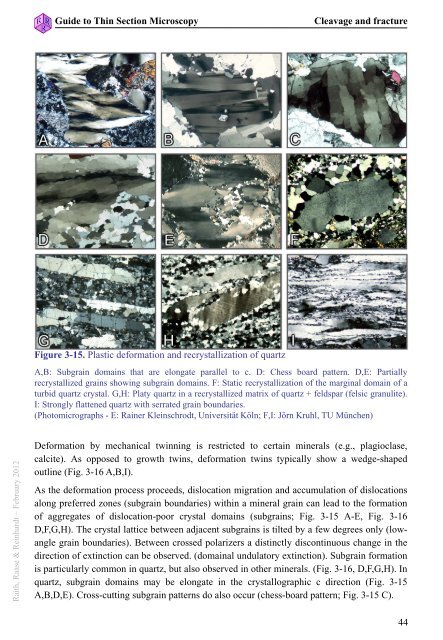guide to thin section microscopy - Mineralogical Society of America
guide to thin section microscopy - Mineralogical Society of America
guide to thin section microscopy - Mineralogical Society of America
Create successful ePaper yourself
Turn your PDF publications into a flip-book with our unique Google optimized e-Paper software.
Guide <strong>to</strong> Thin Section Microscopy<br />
Cleavage and fracture<br />
Figure 3.2-3: Deformation and recrystallisation phenomena<br />
Figure 3-15. Plastic deformation and recrystallization <strong>of</strong> quartz<br />
A,B: Subgrain domains that are elongate parallel <strong>to</strong> c. D: Chess board pattern. D,E: Partially<br />
recrystallized grains showing subgrain domains. F: Static recrystallization <strong>of</strong> the marginal domain <strong>of</strong> a<br />
turbid quartz crystal. G,H: Platy quartz in a recrystallized matrix <strong>of</strong> quartz + feldspar (felsic granulite).<br />
I: Strongly flattened quartz with serrated grain boundaries.<br />
(Pho<strong>to</strong>micrographs - E: Rainer Kleinschrodt, Universität Köln; F,I: Jörn Kruhl, TU München)<br />
Raith, Raase & Reinhardt – February 2012<br />
Deformation by mechanical twinning is restricted <strong>to</strong> certain minerals (e.g., plagioclase,<br />
calcite). As opposed <strong>to</strong> growth twins, deformation twins typically show a wedge-shaped<br />
outline (Fig. 3-16 A,B,I).<br />
As the deformation process proceeds, dislocation migration and accumulation <strong>of</strong> dislocations<br />
along preferred zones (subgrain boundaries) wi<strong>thin</strong> a mineral grain can lead <strong>to</strong> the formation<br />
<strong>of</strong> aggregates <strong>of</strong> dislocation-poor crystal domains (subgrains; Fig. 3-15 A-E, Fig. 3-16<br />
D,F,G,H). The crystal lattice between adjacent subgrains is tilted by a few degrees only (lowangle<br />
grain boundaries). Between crossed polarizers a distinctly discontinuous change in the<br />
direction <strong>of</strong> extinction can be observed. (domainal undula<strong>to</strong>ry extinction). Subgrain formation<br />
is particularly common in quartz, but also observed in other minerals. (Fig. 3-16, D,F,G,H). In<br />
quartz, subgrain domains may be elongate in the crystallographic c direction (Fig. 3-15<br />
A,B,D,E). Cross-cutting subgrain patterns do also occur (chess-board pattern; Fig. 3-15 C).<br />
44
















